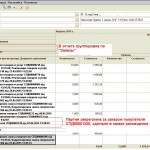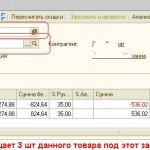Error "Not written off by batches [number] of pieces of goods [goods]". The first thing to do.
If the system issues an error during the execution of the document:
The first thing that needs to be done is to analyze the batches on the report "Statement by lot of goods in warehouses" or in the universal report to perform analysis of the accumulation register "Goods lot in warehouses (management accounting)".
If the error was "Not written off for the parties of organizations", then it is necessary to analyze the accumulation register of the "Goods lot in the warehouses of organizations".
Usually, when analyzing the leftovers of consignments in warehouses, in the report we specify the date of the document that is made with an error as the period, select the current [goods] and group the report by:
- Organization;
- Warehouse;
- Product;
- Document for posting.
If necessary, it can be detailed to documents of movements.
If the remains are not seen, then we understand why they do not exist.
If the remainder is still at the beginning of the date or during this date there is a parish, but the document is still not held. Here, usually, a call to the support service accounting system. But, before you call, try to do a deeper analysis of batches of goods. In addition to the groups listed above:
- Quality;
- Item series;
- Batch status;
- Order.
In this case, the report "Statement on lots of goods in warehouses" will give a complete picture of the problem product for the selected period of analysis.
Why the analysis is necessary before the "Quality" of the goods. There are cases when the goods come to another "Quality", for example "Adjusted goods", and the bill of lading is trying to write off the quality "New".
Analogously, the analysis is up to the "Nomenclature Series". In the bill of lading, users can pomp and fill in the "item series" field in the table section "Goods". However, most likely, the invoice will write off such a consignment automatically, because the series of items are written off according to the FIFO method or it can be selected manually in the implementation document.
Grouping the report on the "Status of the Party" gives you the opportunity to analyze batches by status, usually - the status "Bought", but there may be another status of "Transmitted" and this is just one of the reasons why such a party is not written off.
Grouping the report on the grouping "Order" unfolds the party before the orders under which the parties are placed. If a buyer's order is placed in an order to a supplier and then the supplier has received the goods for this order, then in the consignment note, in the movements of the parties, the "Order" grouping will be filled equal to the order of the buyer that was placed in the order to the supplier.
A similar situation served as an excuse for writing this article, only the placement of the goods was carried out by adjusting the customer's order, where they filled the "order" field in the table section "goods" in the buyer's order adjustment. This example is on screenshots below.
Fig. 1. The report "Statement on lots of goods in a warehouse", which is grouped by all possible groupings, which makes it possible to fully analyze the state of batches for the selected nomenclature. In this example, the lot was placed under the order of the buyer.
Fig. 2. The document "Adjustment of the buyer's order", which places the quantity of the goods in the warehouse, that is, in fact reserves the goods in the warehouse.



